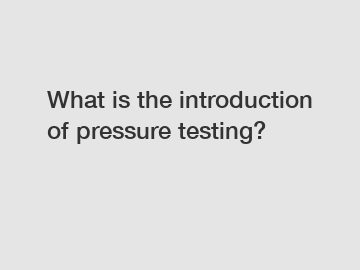What is the introduction of pressure testing?
Understanding Pressure Testing.
Pressure testing is commonly used in industries such as oil and gas, power generation, manufacturing, and construction. It is typically performed on various components, such as pipelines, vessels, valves, boilers, and storage tanks, to ensure they meet the required safety standards. The process involves increasing the pressure inside the system beyond its normal operating level to check for any leaks, structural weaknesses, or potential failures.
Importance of Pressure Testing.

Pressure testing plays a vital role in ensuring the reliability and safety of the systems and components that operate under high-pressure conditions. By subjecting them to elevated pressures, any potential weaknesses or defects can be identified, thus minimizing the risk of catastrophic failures during operation. It provides valuable insights into the performance and limitations of the systems, allowing for necessary improvements or repairs to be made before actual operation.
Applications of Pressure Testing.
1. Oil and Gas Industry.
In the oil and gas industry, pressure testing is extensively used to verify the integrity of pipelines, wellheads, and other critical equipment. It helps in identifying any potential leaks or weak points that could lead to spills, accidents, or environmental hazards. Through pressure testing, oil and gas companies can prevent costly interruptions, maintain operational efficiency, and ensure compliance with stringent safety regulations.
2. Power Generation.
The power generation sector heavily relies on pressure testing to ensure the safe operation of boilers, turbines, and condensers. By subjecting these components to rigorous pressure tests, potential issues such as leaks, cracks, or material fatigue can be detected. This helps power plants to enhance their performance, prevent downtime, and improve overall safety standards.
3. Manufacturing and Construction.
In manufacturing and construction industries, pressure testing is used to validate the quality and safety of various products and structures. For instance, pressure testing of water pipes ensures they can withstand the required water pressure without any leaks or bursts. Similarly, pressure tests are conducted on automotive parts, aerospace components, and hydraulic systems to ensure their reliability and durability.
Conclusion.
Pressure testing is a fundamental process that ensures the safety, integrity, and reliability of systems and components operating under high-pressure conditions. It helps identify any potential weaknesses or failures, allowing for corrective measures to be taken before actual operation. From oil and gas industry to power generation, and manufacturing to construction, pressure testing finds its applications in various sectors. By conducting regular pressure testing, industries can minimize the risk of accidents, avoid costly downtime, and ensure compliance with safety regulations.
If you have any further questions or need assistance with pressure testing, feel free to contact us. Our experts are available to provide guidance and support for all your pressure testing needs.
For more information, please visit booster pump air, c02 gas pumps, booster gas.


